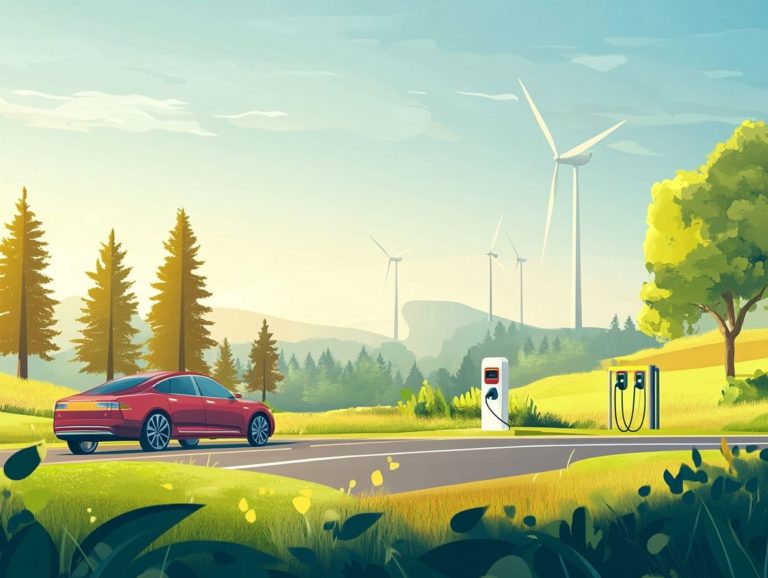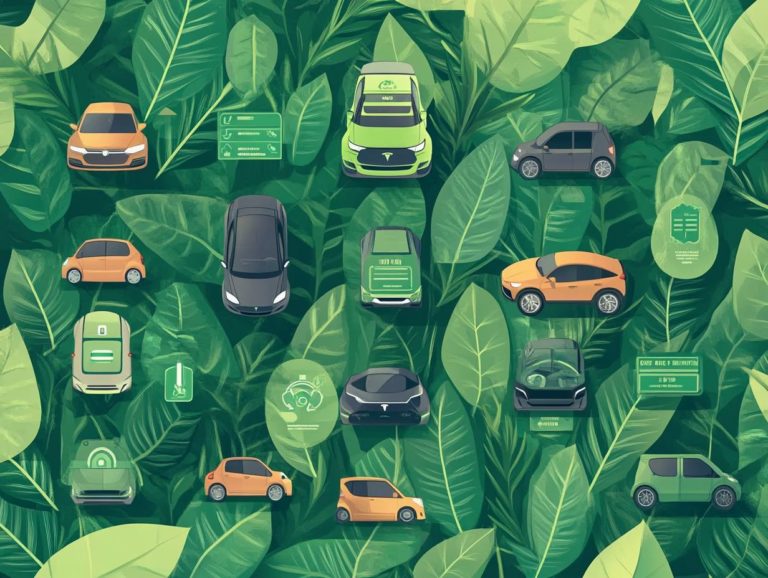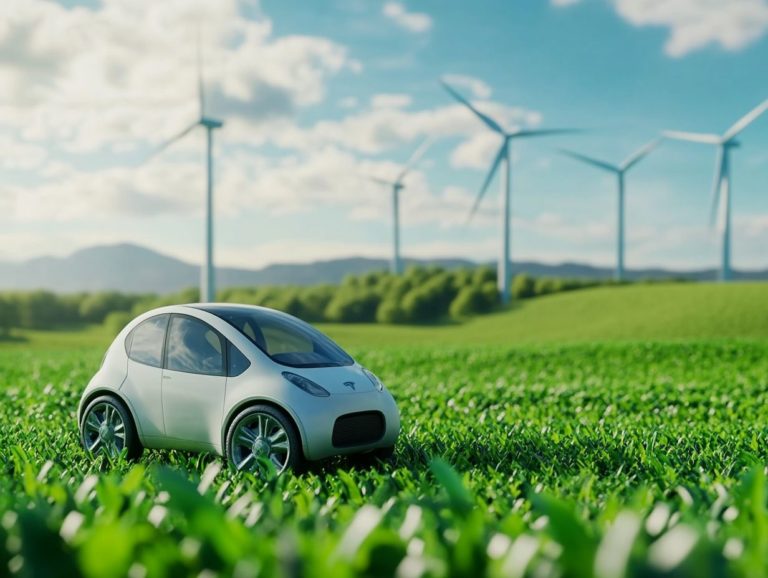Comparing EVs and Hybrid Vehicles for Sustainability
As the world increasingly prioritizes sustainability, electric vehicles (EVs) and hybrid vehicles have emerged as key players in the automotive landscape.
This article delves into the environmental impact of these innovative machines, weighing their carbon footprint and emissions against those of traditional vehicles.
You ll also explore cost comparisons, examining initial investments in contrast to long-term savings.
Performance metrics and infrastructure needs will be discussed, along with guidance on choosing the right vehicle to suit your personal or business requirements.
Join us on an exciting journey as you navigate the world of eco-friendly transportation options.
Contents
Key Takeaways:
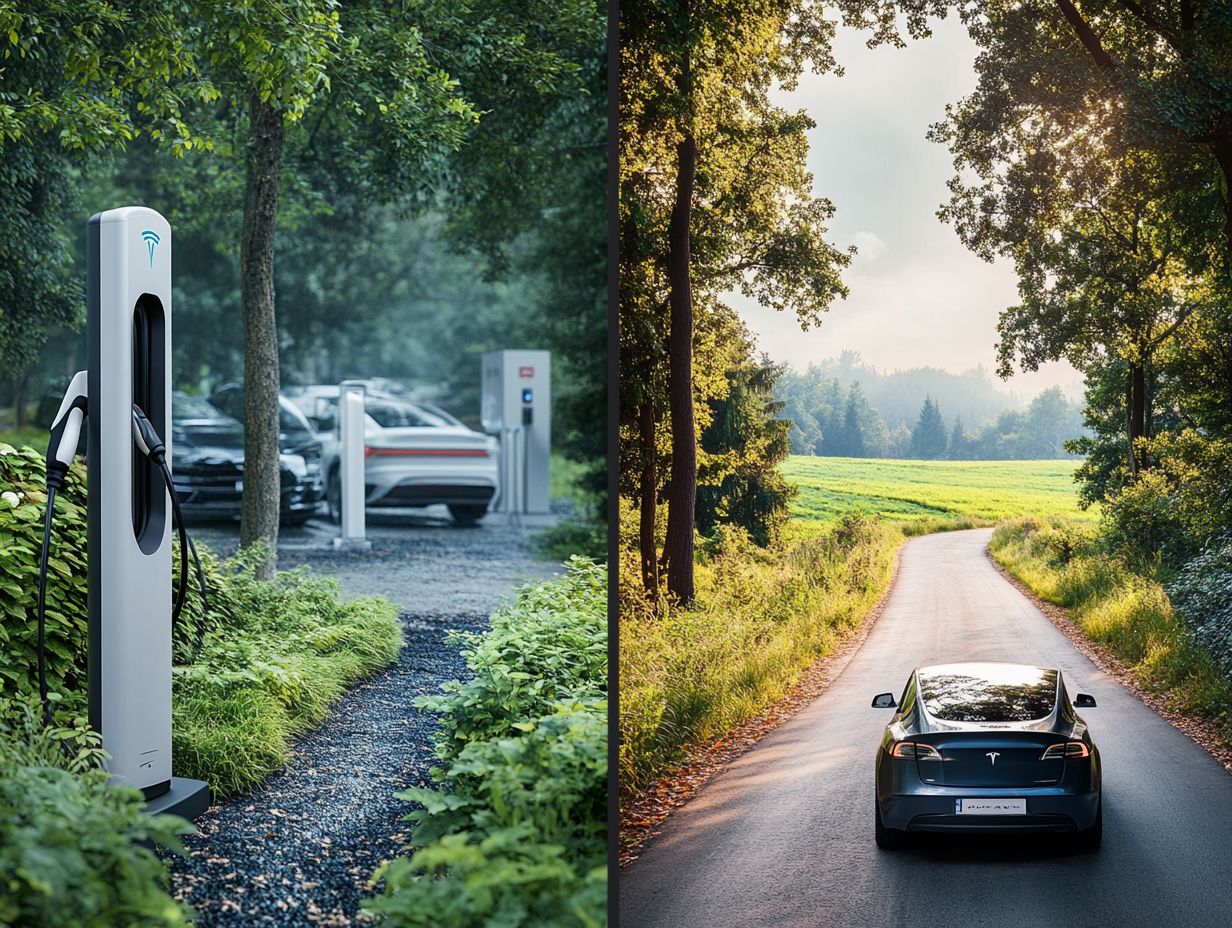
- EVs and hybrid vehicles have a lower environmental impact compared to traditional gasoline cars, helping to reduce carbon footprints and emissions.
- While EVs may have a higher initial investment, they offer long-term savings through lower maintenance and fuel costs. Hybrid vehicles may be a more cost-effective option for those with shorter commutes.
- Performance and range differ between EVs and hybrids, with EVs typically offering more power, speed, and distance capabilities. Infrastructure and charging/refueling options also play a role in convenience and practicality.
What are EVs and Hybrid Vehicles?
Electric vehicles (EVs) and hybrid vehicles (HEVs) represent a remarkable evolution in automotive technology, designed to offer eco-friendly transportation solutions that tackle challenges posed by traditional cars that run on gasoline or diesel. For those looking to make informed choices, checking sustainability ratings for electric vehicle models is essential. These vehicles employ advanced battery systems and electric motors to minimize emissions and enhance fuel efficiency, positioning themselves as key players in the future of transportation.
You ll find that electric vehicles primarily fall into three main categories: battery electric vehicles (BEVs), plug-in hybrid electric vehicles (PHEVs), and hybrid electric vehicles (HEVs). BEVs operate exclusively on electricity from rechargeable batteries, while PHEVs cleverly combine an electric motor with an internal combustion engine, providing greater flexibility in energy use.
HEVs utilize both power sources but primarily depend on gasoline. The technology behind these vehicles is impressive; electric motors deliver instant torque and superior efficiency, whereas internal combustion engines often lag in both areas.
As the automotive industry embraces these greener alternatives, your daily commutes and long-distance travels are poised for transformation, paving the way for a healthier planet for generations to come.
Environmental Impact of EVs and Hybrid Vehicles
The environmental impact of electric vehicles (EVs) and hybrid vehicles (HEVs) is significant, as they dramatically reduce emissions compared to traditional internal combustion engine vehicles (ICEVs). To make the best choice, it’s important to know how to compare EV models effectively.
This decline in emissions not only supports sustainability objectives but also offers substantial climate benefits, aligning perfectly with eco-conscious aspirations.
Reducing Carbon Footprint and Emissions
Reducing carbon footprints and emissions is a primary advantage of electric vehicles (EVs) and hybrid vehicles (HEVs) since they utilize electric power sources that significantly lower lifecycle emissions compared to traditional vehicles.
These vehicles leverage advanced battery systems to increase their efficiency, granting you longer ranges between charges and reducing reliance on fossil fuels. When charged using renewable energy sources like solar or wind power, the sustainability aspect of EVs becomes even more pronounced. For a deeper understanding, check out why EVs are crucial for a sustainable future, effectively minimizing greenhouse gas emissions throughout their operational life.
Innovations in battery recycling and energy density play crucial roles in enhancing the environmental friendliness of these vehicles, ensuring that the entire ecosystem from production to end-of-life contributes to a greener planet for everyone.
Switching to EVs and hybrids is not just a choice it’s a vital step towards saving our planet!
Cost Comparison of EVs and Hybrid Vehicles
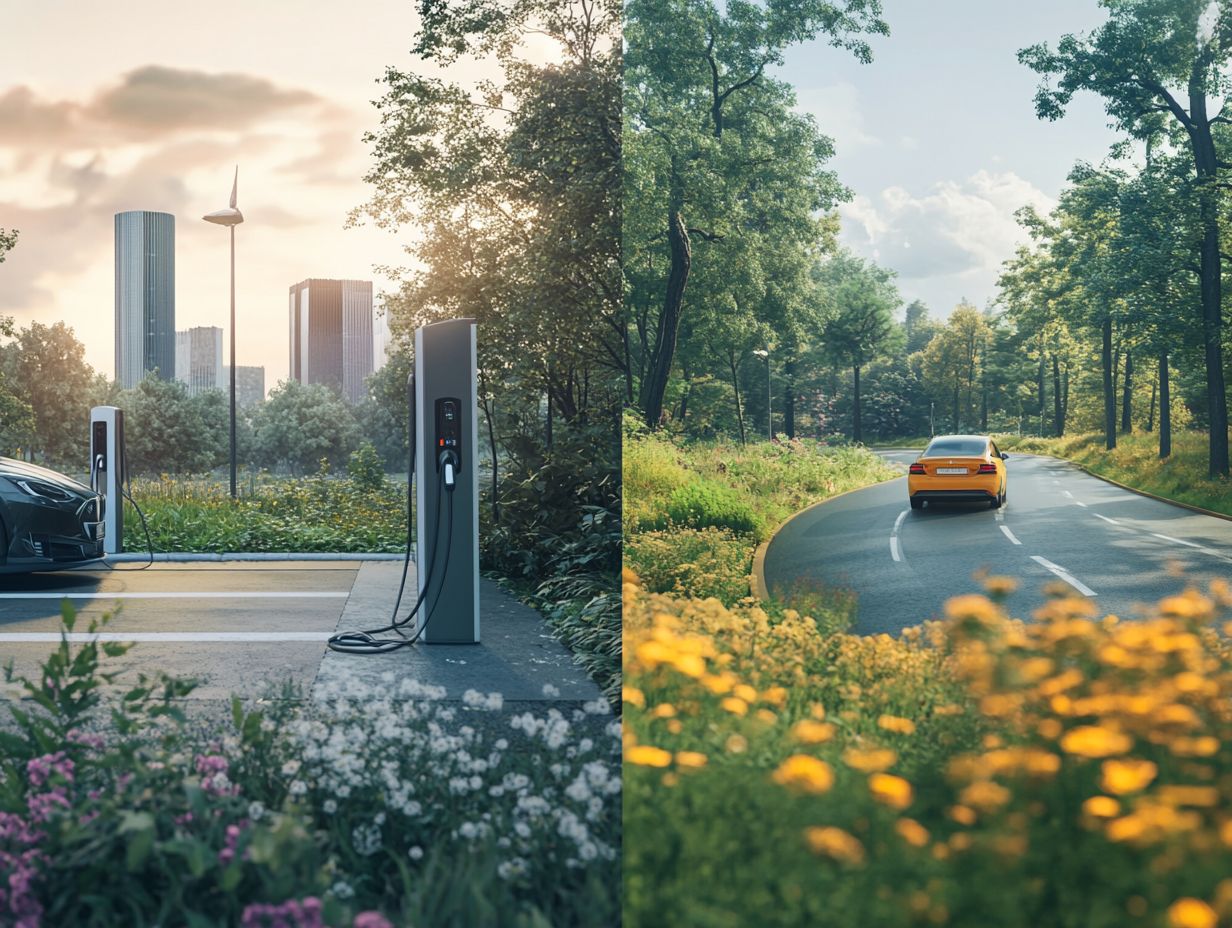
When you weigh the cost comparison between Electric Vehicles (EVs) and Hybrid Vehicles (HEVs), it’s essential to assess not only the initial investment but also the potential long-term savings, including factors like their environmental impact and evaluating the sustainability of the EV industry.
These savings can stem from lower energy costs and attractive government incentives, including federal tax credits.
Initial Investment and Long-Term Savings
The initial investment in Electric Vehicles (EVs) and Hybrid Vehicles (HEVs) might seem steep compared to traditional vehicles. However, the long-term savings from lower energy costs and available federal tax credits can significantly offset those upfront expenses.
When you assess the ongoing savings from reduced fuel expenses and decreased maintenance costs, you may find that your vehicle essentially pays for itself over time.
Federal tax credits can vary widely, ranging from a few thousand dollars to substantial amounts, depending on the model and its battery capacity. This only enhances affordability.
Various state incentives and rebates may also apply, making the financial decision even more enticing. You ll likely discover that the cumulative savings from choosing an EV or HEV paired with the undeniable environmental benefits can justify the initial costs in ways that traditional vehicles often cannot.
Performance and Range Comparison
Understanding the performance and range of Electric Vehicles (EVs) versus Hybrid Vehicles (HEVs) is crucial for consumers. It enables you to grasp their power, speed, and distance capabilities while addressing important concerns such as the fear of running out of battery while driving and battery life. For deeper insights, explore the future of transportation with EVs and sustainability.
This knowledge helps you make informed decisions that align with your driving needs and preferences.
Power, Speed, and Distance Capabilities
Electric Vehicles (EVs) are renowned for their remarkable power and speed, frequently outpacing traditional internal combustion engine vehicles in terms of acceleration. Your driving experience will largely hinge on battery life, a crucial factor that plays a significant role in alleviating range anxiety.
In contrast to hybrid electric vehicles (HEVs), which utilize a blend of an internal combustion engine and an electric motor, the efficiency of EVs becomes strikingly apparent across various driving conditions.
While HEVs can indeed offer better fuel economy, especially in stop-and-go traffic, EVs often provide a more fluid power delivery that enhances both speed and responsiveness.
As technology continues to evolve, these vehicles not only showcase impressive performance but also address persistent concerns about range through innovative solutions like rapid charging stations and longer-lasting battery life.
With manufacturers prioritizing these advancements, you can feel confident that your electric vehicle can meet your daily demands without the anxiety of unexpected outages.
Infrastructure and Convenience Factors
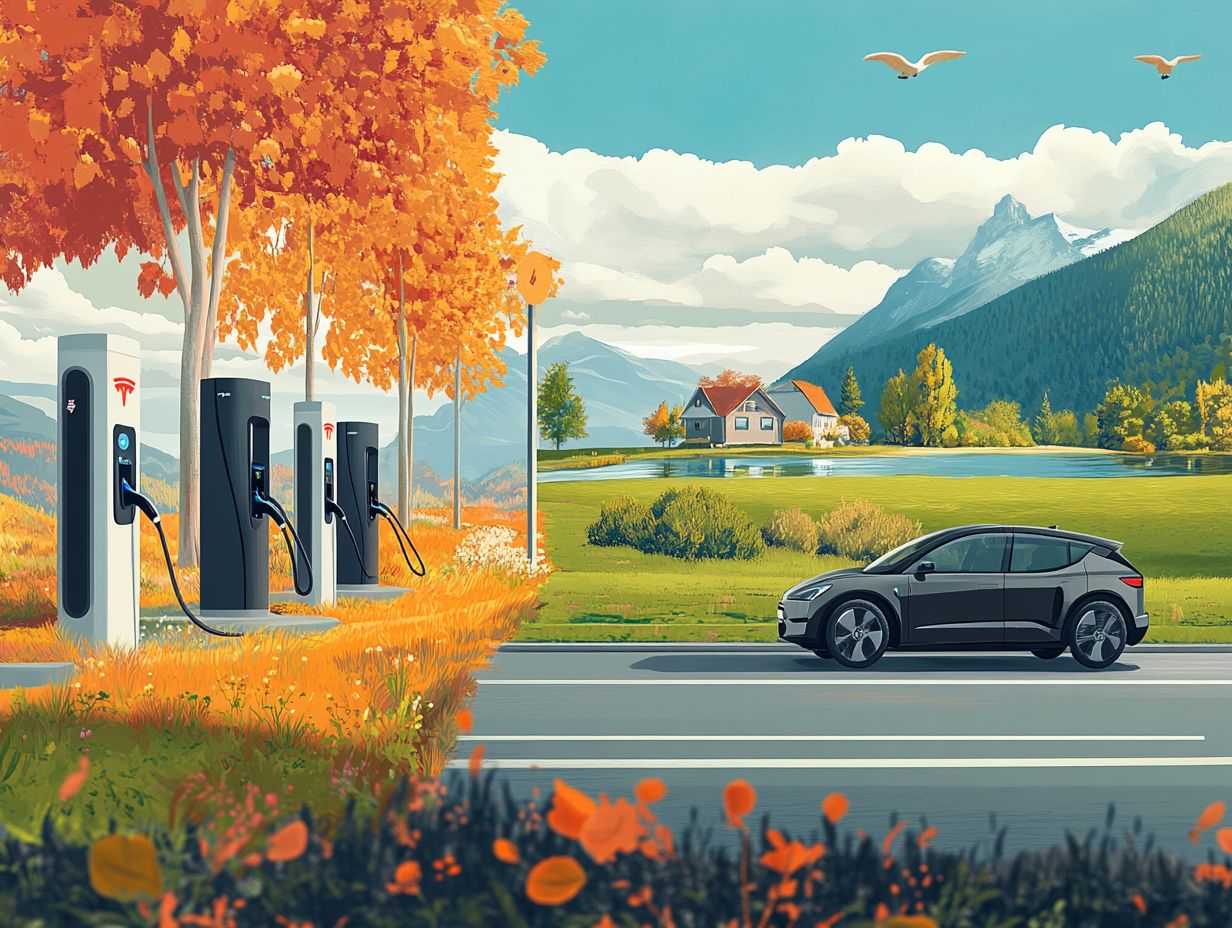
Infrastructure and convenience factors play a pivotal role in the broader acceptance of Electric Vehicles (EVs) and Hybrid Vehicles (HEVs). The availability of charging infrastructure and public charging stations significantly enhances the overall user experience and bolsters energy security.
It s essential for you to consider these elements as you navigate the transition to more sustainable transportation options.
Take the leap into sustainable driving discover the perfect vehicle for your lifestyle today!
Charging and Refueling Options
Charging and refueling options for Electric Vehicles (EVs) and Hybrid Vehicles (HEVs) are becoming increasingly diverse. This variety enhances your driving experience and offers a rich tapestry of choices. With an expanding network of charging stations, you ll find various levels of convenience and accessibility tailored to your needs.
As cities embrace more sustainable initiatives, you’ll notice a growing availability of fast chargers, standard Level 2 stations, and slower Level 1 options. Fast chargers are often found in shopping centers, highway rest stops, and busy urban areas. They can rejuvenate nearly 80% of your EV’s battery in just 30 minutes perfect for those exhilarating road trips.
Level 2 chargers, typically located at workplaces and residential complexes, may require a few hours for a full charge. This difference in charging speed creates a notable contrast with traditional refueling, which usually takes only minutes. The quicker refueling process of gasoline vehicles has historically caused some hesitancy to transition to electric alternatives.
However, as charging infrastructure continues to evolve, expect to see more drivers choosing EVs and HEVs. This shift is not just appealing but also practical.
Choosing the Right Vehicle for Your Needs
Selecting the ideal vehicle, whether an Electric Vehicle (EV) or a Hybrid Vehicle (HEV), requires thoughtful consideration of your unique needs, preferences, and intended applications, especially in light of the growing importance of EV sustainability, be it for personal use or business purposes.
It s essential that the vehicle you choose aligns with your lifestyle and aspirations, ensuring a perfect match for your goals.
Considerations for Personal and Business Use
When evaluating Electric Vehicles (EVs) and Hybrid Vehicles (HEVs) for personal or business use, it’s crucial to consider consumer preferences, vehicle efficiency, and the connection between EVs and sustainable living, as well as the potential for reducing energy costs in your daily operations.
Understanding the long-term financial implications is vital. While the upfront costs of EVs may be higher, savings on fuel and maintenance can turn them into a smart investment over time. For your business, adding EVs and HEVs to your fleet boosts operational efficiency and aligns with sustainability goals, which are increasingly important to your customers and investors.
These vehicles often come with attractive tax incentives and rebates, enhancing their financial benefits. Plus, the expanding network of charging stations makes EVs more convenient for individual users and corporate fleets. Embracing these eco-friendly options shows a commitment to environmental responsibility, enhancing your brand in today s conscientious market.
Frequently Asked Questions

Differences Between EVs and Hybrid Vehicles
EVs run solely on electricity and do not have a traditional gasoline engine. In contrast, hybrid vehicles use both an electric motor and a gasoline engine to power the vehicle.
Sustainability Comparison
In terms of sustainability, EVs are considered more environmentally friendly as they produce zero emissions when running on electricity. However, if you’re deciding between options, understanding how to choose between hybrid and electric vehicles is essential, as hybrid vehicles still emit some pollutants from their gasoline engine.
Cost Differences
Typically, EVs cost more upfront, but they save money over time since they do not require gasoline and have lower maintenance costs.
Driving Ranges
The driving range of an EV depends on its battery capacity, but on average, it can travel anywhere from 100 to 300 miles on a single charge. Hybrid vehicles generally have a shorter range but can switch to gasoline when the battery runs out.
Environmental Impact
Both EVs and hybrid vehicles have a similar environmental impact during manufacturing. However, to better understand their benefits, it’s important to explore how to evaluate sustainable practices in EVs, as they do not contribute to air pollution, making them the more sustainable option.
Act now to embrace greener alternatives that can transform your driving experience! Join the electric revolution today and drive into a sustainable future!
Can Electric Vehicles (EVs) and hybrid vehicles be charged at home?
Yes! You can easily charge both types of vehicles at home.
Electric Vehicles (EVs) need a special charging station, while hybrids can be plugged into any standard outlet. It’s that simple!

